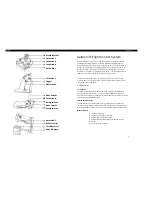
FP
Σ
User's Manual
7.2 Function Specifications and Restrictions
105
7.2.4 Restrictions
Restrictions on channels
The maximum counting speed of the high-speed counter function and the maximum output
frequency of the pulse output function are determined by the number of channels used and
the combination of the two functions. The same channel cannot be used by more than one
function.
REFERENCE
Please refer to the specifications for the exact values of maximum counting
speed and maximum output frequency. See "Maximum counting speed and
output frequency" on page 280.
Restrictions on I/O allocations
•
The inputs and outputs cannot be allocated to more than one function.
•
Inputs and outputs that have been allocated to a high-speed counter or pulse output
function cannot be used as normal inputs or outputs. Exceptions:
-
If no reset input is used in the high-speed counter function, X2 and X5 can be
used as normal inputs.
-
If no deviation counter clear output is used in the pulse output function, Y2 and Y5
can be used as normal outputs.
Restrictions on instructions
•
When using the pulse output instructions
F171
,
F172
,
F174
, and
F175
specify the
initial frequency to 30kHz or less. Otherwise, the first pulse may be lost.
•
The high-speed counter control flag (e.g. sys_bIsHscChannel0ControlActive) and the
pulse output control flag (e.g. sys_bIsPulseChannel0Active) are assigned to the same
internal relay (e.g. R903A). Therefore, when a high-speed counter instruction or a
pulse output instruction is executed, both the high-speed counter control flag (e.g.
sys_bIsHscChannel0ControlActive) and the pulse output control flag (e.g.
sys_bIsPulseChannel0Active) for the channel used are TRUE. No other high-speed
counter instruction or pulse output instruction can be executed as long as this flag is
TRUE.
•
The status of the high-speed counter control flag or pulse output control flag may
change while a scan is being carried out. For example, if the flag is used more than
once as an input condition, different statuses may exist within one scan. To ensure
proper execution of the program, the status of the special internal relay should be
copied to a variable at the beginning of the program.
•
Executing the circular interpolation control instruction
F176
sets the circular
interpolation control flag (sys_bIsCircularInterpolationActive) to TRUE. The status of
this flag is maintained until the target value is reached (even if the execution condition
is no longer TRUE). During this time, other pulse output instructions cannot be
executed.
Summary of Contents for FPS Series
Page 7: ......
Page 17: ......
Page 18: ...Chapter 1 Safety Measures...
Page 21: ......
Page 22: ...Chapter 2 Overview...
Page 32: ...Chapter 3 CPU Types...
Page 47: ...CPU Types FP User s Manual 30 LD Body...
Page 51: ...CPU Types FP User s Manual 34 POU Header and LD Body...
Page 55: ...CPU Types FP User s Manual 38 LD Body...
Page 57: ......
Page 58: ...Chapter 4 Expansion...
Page 73: ......
Page 74: ...Chapter 5 I O Allocation...
Page 81: ......
Page 82: ...Chapter 6 Installation and Wiring...
Page 115: ......
Page 116: ...Chapter 7 High Speed Counter and Pulse Output...
Page 169: ......
Page 170: ...Chapter 8 Communication...
Page 227: ...Communication FP User s Manual 210 LD Body ST Body...
Page 233: ...Communication FP User s Manual 216 POU Header LD Body...
Page 236: ...FP User s Manual 8 6 Program Controlled Communication 219 POU Header LD Body 1 2...
Page 237: ...Communication FP User s Manual 220 2 2 ST Body...
Page 266: ...Chapter 9 Security Functions...
Page 273: ......
Page 274: ...Chapter 10 Other Functions...
Page 277: ......
Page 278: ...Chapter 11 Troubleshooting...
Page 289: ......
Page 290: ...Chapter 12 Appendix...















































